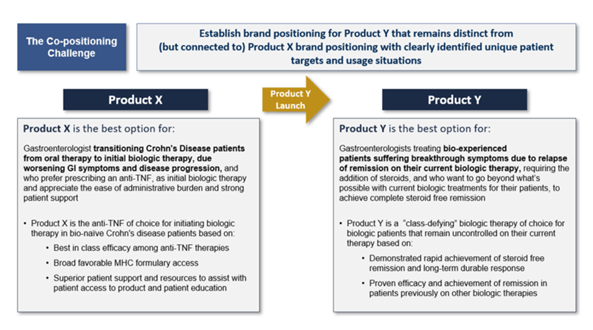A strong portfolio of treatments can improve outcomes for a range of patients and improve product performance by showing a commitment to the therapeutic area. The challenge is to continue to develop products for the same indication without cannibalizing existing products. In this situation, distinct co-positioning is essential to the success of both products. The complexity of multiple brands within the same product portfolio and therapeutic area causes a lack of clarity around the distinction between the appropriate patient type, usage situation, and differentiated benefits for each product if proper co-positioning is not developed. The result may be sub-optimal performance for all the products. In this post, we will share quick tips for developing co-positioning. For more detail and examples, read our recent white paper, HOW TO CREATE CLEAR CO-POSITIONING LANES FOR PRODUCTS SHARING THE SAME INDICATION.
When Do Pharmaceutical Companies Use Co-Positioning?
Pharma companies often develop an enhanced or next-generation product that shares the same indication as a currently marketed product in the franchise portfolio. This can create a situation where there is a need to develop a distinct position for the new product and often re-position the existing product. In order to have distinct patients for each product associated with different usage situations
The goal is to create an easy way for providers to understand which patients can benefit from each product in which usage situations.
Developing Strong Co-Positioning Within a Brand Portfolio
When establishing a co-positioning strategy for launching a product, marketing needs to ensure that there is clarity around the unmet medical need each product addresses and that they do not compete with each other. Clear, focused articulation of the co-positioning helps HCPs recognize appropriate patients and usage situations to get the best therapy to patients.
Co-positioning Two Portfolio Products
In addition to understanding the patient core benefits, identifying the physician attitudinal segmentation is needed as the “For Who” of the positioning statement. Then marketers should determine, based on each portfolio product’s value proposition, what are the most valued functional and emotive benefits each is delivering.
Once you have identified the distinct HCP target segment that aligns with each brand’s value proposition based on its ability to address the desired unmet needs of that segment, you can then determine where each product “will play” in the market.
“Best in Class” patient services can be a differentiator for a brand. Brand teams should consider building outpatient support services to differentiate their product further and provide additional value when applicable.
Co-positioning Statements
This simplified example depicts the co-positioning of two portfolio products, both indicated for Crohn’s disease, a chronic inflammatory bowel disease that affects the lining of the digestive tract. Symptoms of this disease include abdominal pain, diarrhea, weight loss, and fatigue. Treatments vary from initial oral therapies such as anti-inflammatory drugs and can progress to immune system suppressors and injectable biologic therapies.

The newly launched product (Product Y) is an injectable biologic with a more advanced MOA. It provides distinct clinical benefits from the existing product in the portfolio (Product X), which is also an injectable biologic therapy. Subsequently, each product has unique HCP and patient targets based on their ability to address each target’s unmet need and different usage situations. It is also important to note that Product X has functional benefits beyond its clinical profile. You will notice that “Superior Patient Support Services” is an identified benefit in Product X’s profile.
Summary
Herspiegel works for dozens of pharma companies that have a portfolio with overlapping brands. Designing an effective co-positioning strategy is the key to increasing market share and defending against emerging competition.
With a portfolio of treatments, pharma companies can improve outcomes for a range of patients within the same indication by showing commitment to the therapeutic area – without cannibalizing existing products. It is essential to ensure that promotional resources and messaging are aligned with your portfolio strategy and brand positioning across all personal and non-personal promotion channels. Also, you may want to consider going beyond developing just HCP promotional resources and delivering patient support services that further meet the needs of the identified target patient types. This will further strengthen the pharma brand’s reputation within that disease community and should not be forgotten as part of the launch strategy.
For more detail and examples, read our recent white paper, HOW TO CREATE CLEAR CO-POSITIONING LANES FOR PRODUCTS SHARING THE SAME INDICATION.
Are you managing a portfolio of products?
Herspiegel helps our clients define impactful strategic approaches, streamline launch and commercialization processes, enhance business intelligence, and optimize product performance. Let’s talk.


